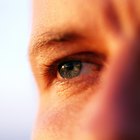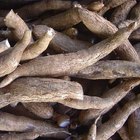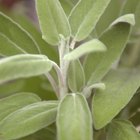Burdock, otherwise known as lappa or niu bang zi, is one of the most well-known detoxifying herbs used in Western and Chinese herbal medicine. Recommended primarily as a blood purifier, burdock cleanses the body of bile and eliminates toxins that can cause chronic skin conditions. While further scientific research is needed to confirm burdock root's efficacy in treating complexion problems, it has a lengthy reputation as a folk remedy for boils, abscesses and acne.
Please consult your physician before attempting herbal remedies at home.
Identification
A common wayside weed, burdock is a relative of the daisy. It grows to a height of three to four feet and bears large, wavy leaves and purple flower heads that stick to clothes and fur. Native to Asia and Europe, burdock is now grown widely throughout the United States. The gray-red seeds are harvested in summer when the deep, black roots of two-year-old plants are unearthed for medicinal purposes.
History
Burdock has a long history in cleansing the body of waste products, and clearing congestion in circulatory, lymphatic, respiratory and urinary systems. European and Chinese herbal practitioners have used burdock root and seeds for centuries in treating skin conditions, especially where toxicity is a key factor, such as eczema, psoriasis, local skin infections and acne.
Europeans use burdock root oil extract to improve hair strength and shine and to treat itchy scalp, dandruff and hair loss. The University of Maryland Medical Center says that practitioners of traditional Chinese medicine use burdock to treat sore throats and colds. In addition, some Europeans and the Japanese eat burdock as a vegetable to improve digestion.
Benefits
According to the website Health911.com, "The herb burdock is effective in treating acne and is the most important herb for treating all forms of chronic skin problems." A 1967 German study reported in the book "Encyclopedia of Herbal Medicine" found that burdock root contains polyacetylenes, antifungal and antibiotic qualities that help fight acne-causing bacteria and fungi that infect cracked skin. Its diuretic action aids in eliminating impurities through the digestive system, rather than the skin where toxins can cause infections.
The herb yields particularly valuable benefits on eruptive and inflamed pimples. The website HerbalLegacy.com adds, "The beneficial effects of this herb include increasing circulation to the skin, helping to detoxify the epidermal tissues."
Dosage
Although safety and effectiveness have not been confirmed, according to "Prescription for Herbal Healing," traditional herbalists suggest taking 1 to 2 g three times daily in capsule form. You can also make a tea with 2 tsp. dried burdock root and 5 tsp. dandelion root. Drink one cup two times a day for pimples.
Considerations
Pregnant and nursing women should avoid using burdock as large quantities may stimulate the uterus and damage the fetus. Do not take burdock if you have allergic reactions to daisies, marigolds, chrysanthemums or ragweed.
The University of Maryland Medical Center states that commercial preparations are prone to contamination with the root of belladonna or deadly nightshade, both potentially harmful herbs. Purchase well-respected brands of burdock and do not harvest burdock root from the wild.
Related Articles

How to Choose Quality Korean Ginseng

Can Herbs Flush Cellulite?

List of Retinoids

What Is Aloe Good For?

What Are the Benefits of Ashwagandha in ...

The Use of Neem Juice in Skin Care as ...

Arnica for Acne

Wild Yam for Hair Growth

Anise Seed Cautions and Side Effects

How to Eat Fenugreek

What Are the Benefits of Extrapone ...

Chamomile & Aloe Skin Care

Bitter Melon for Acne

Eucalyptus Oil & Acne

Metamucil Dosage for Cats

The Benefits of Lemongrass for Skin

How to Cook Yucca Root

How to Use Sage to Combat Hair Loss

Pycnogenol and Acne

Peeling the Spiny Chayote Squash
References
- "Prescription for Herbal Healing"; Phyllis A. Balch; 2002
- Health911: Acne
- University of Maryland Medical Center: Burdock
- "Encyclopedia of Herbal Medicine"; Andrew Chevallier; 2000
- Herbal Legacy: Medicinal Qualities of Burdock
Writer Bio
Susan DeFeo has been a professional writer since 1997. She served as a community events columnist for New Jersey's "Cape May County Herald" for more than a decade and currently covers the family and pet beat for CBS Philadelphia. Her health, fitness, beauty and travel articles have appeared in various online publications. DeFeo studied visual communications at SUNY Farmingdale.